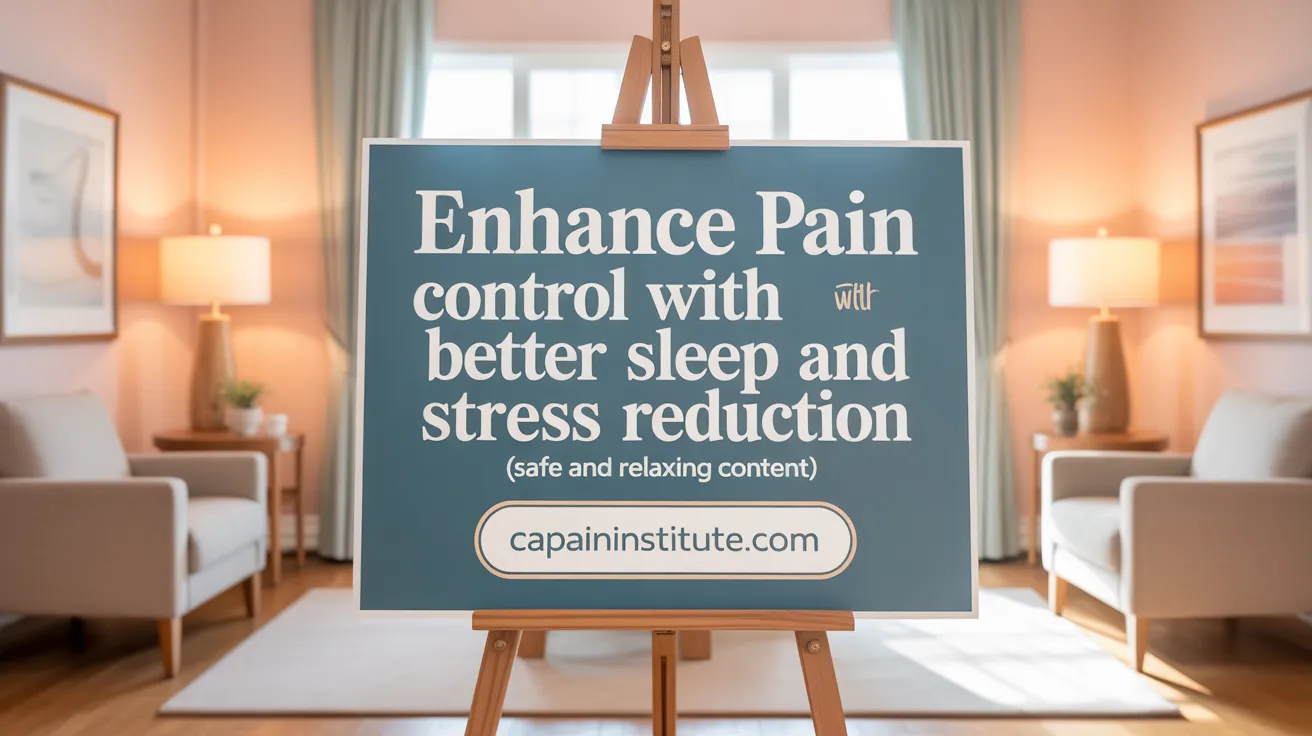The Growing Role of Lifestyle in Pain Management
Chronic pain remains a complex health challenge, often resistant to conventional treatments. Recent advances underscore the critical influence of lifestyle factors such as diet, exercise, sleep, and stress management on pain experiences and outcomes. This article explores the scientific evidence supporting lifestyle modifications in pain relief, practical strategies for patients, and how personalized approaches enhance pain management success.
Effective Lifestyle Modifications for Chronic Pain Relief
 Chronic pain management increasingly involves lifestyle adjustments that can make a significant difference in symptoms and overall well-being. Engaging in regular physical activity, such as walking, swimming, or gentle stretching, helps strengthen muscles, improve flexibility, and reduce pain. Even 20 minutes of daily movement can lower inflammation and increase endorphin levels, natural pain relievers.
Chronic pain management increasingly involves lifestyle adjustments that can make a significant difference in symptoms and overall well-being. Engaging in regular physical activity, such as walking, swimming, or gentle stretching, helps strengthen muscles, improve flexibility, and reduce pain. Even 20 minutes of daily movement can lower inflammation and increase endorphin levels, natural pain relievers.
Stress is a common contributing factor to chronic pain. Techniques like mindfulness, deep breathing, meditation, yoga, and hobbies can reduce stress levels and help manage pain more effectively. These practices lower cortisol, relax muscles, and improve mental resilience.
A well-balanced diet rich in anti-inflammatory foods—such as fruits, vegetables, omega-3 fatty acids from fish, and whole grains—can reduce systemic inflammation linked to pain. Avoiding processed foods, sugary drinks, and trans fats is equally important to mitigate inflammation.
Sleep hygiene plays a vital role. Establishing a consistent bedtime routine, creating a sleep-friendly environment, and avoiding electronic devices and caffeine before bed help promote restorative sleep. Good sleep reduces pain sensitivity and enhances healing.
Practicing proper posture, ergonomic adjustments, and avoiding heavy lifting can prevent strain on joints and muscles. Quitting smoking improves blood flow, reduces pain sensitivity, and supports healing processes.
Maintaining a healthy weight through diet and physical activity decreases pressure on weight-bearing joints and lowers the risk of conditions like osteoarthritis. Weight loss can alleviate pain and improve mobility.
Combining these lifestyle changes with medical treatment offers a comprehensive approach to managing chronic pain, often leading to better outcomes and an improved quality of life.
Nutrition’s Impact: Anti-Inflammatory Diets and Pain

What role does nutrition play in chronic pain management?
Nutrition significantly influences the mechanisms underlying chronic pain, including inflammation, oxidative stress, and metabolic processes involving glucose and lipids. Inadequate nutritional intake or unhealthy dietary habits can exacerbate pain symptoms, whereas proper nutrition can help alleviate them. Dietary patterns rich in anti-inflammatory foods, such as the Mediterranean and plant-based diets, provide essential nutrients like vitamin D, omega-3 fatty acids, magnesium, zinc, and folate, which help reduce inflammation. Personalized dietary interventions guided by dietitians are crucial for effective pain management.
Good nutrition also supports overall health, enhances immune function, and can improve mood and energy levels, all of which contribute to better pain management outcomes. As one of the most modifiable lifestyle factors, optimizing diet is a practical approach to controlling chronic pain.
Which foods are recommended or should be avoided for managing chronic pain?
For reducing inflammation and pain, focus on incorporating a variety of antioxidant-rich foods and healthy fats. Recommended foods include:
- Fruits and vegetables
- Whole grains
- Nuts and seeds
- Fatty fish such as salmon, sardines, and mackerel
- Herbs and spices like turmeric, ginger, and herbs
These foods contain compounds that combat inflammation and support tissue healing.
Conversely, it is advisable to limit or avoid foods known to promote inflammation, such as:
- Processed meats and red meats
- Refined carbohydrates, including white bread, pastries, and white rice
- Sugary foods and beverages
- Trans fats found in fast foods and processed snacks
- Foods high in saturated fats
Excessive consumption of alcohol and caffeinated beverages, as well as foods containing MSG or high omega-6 fatty acids, should also be moderated or avoided.
Maintaining adequate hydration and choosing nutrient-dense foods rich in antioxidants can further contribute to pain reduction. Combining these dietary strategies with lifestyle practices like regular exercise and stress management can create a comprehensive approach to pain relief.
Physical Activity and Mind-Body Practices to Alleviate Pain
Exercise types and benefits
Engaging in regular physical activity can significantly improve chronic pain conditions, especially in cases like lower back pain and arthritis. Aerobic exercises such as walking, swimming, and cycling help strengthen muscles, improve joint flexibility, and boost circulation. Strengthening exercises targeting core muscles support spinal stability, while flexibility routines help reduce stiffness.
Mind-body approaches like yoga and tai chi
Practicing mind-body exercises like yoga and tai chi offers additional benefits. These gentle movements combined with breathing exercises and meditation help improve posture, reduce muscle tension, and enhance mental well-being. Studies have shown that such practices can lower pain intensity and improve quality of life for chronic pain sufferers.
Muscle strength and flexibility
Maintaining muscle strength and flexibility is essential in managing chronic pain. Regular stretching and low-impact strength training can prevent stiffness and support musculoskeletal health. Strengthening the core can also improve posture, reduce strain, and decrease the likelihood of injury.
Pain-specific exercise tailoring
Exercise programs should be tailored to individual conditions and pain mechanisms. Consulting healthcare professionals ensures exercises are appropriate, safe, and effective. Custom plans often include gradual progression to prevent exacerbating pain or causing injury.
Role of low-impact activities
Low-impact activities like walking, swimming, and Pilates are particularly suitable for individuals with joint or back pain. These activities minimize stress on the joints while promoting muscle engagement, flexibility, and overall health.
Sedentary lifestyles and pain risk
A sedentary lifestyle increases the risk of developing musculoskeletal issues and can worsen existing pain by reducing synovial fluid production and causing muscle weakness. Incorporating daily movement helps alleviate these risks and supports pain management.
Evidence indicates that integrating a variety of these physical activities and mind-body techniques can lead to better pain control, enhanced mobility, and improved mental health, contributing to a comprehensive approach to managing chronic pain.
Sleep and Stress Management: Pillars of Pain Control

How does poor sleep influence pain?
Poor sleep quality is closely linked to increased pain perception and can exacerbate chronic pain conditions such as lower back pain and arthritis. Sleep deprivation hampers the body’s ability to repair tissues, maintain immune function, and regulate inflammation. When individuals do not get restorative sleep, they often experience a lowered pain threshold, making existing pain feel more intense.
Strategies to improve sleep include establishing consistent routines, avoiding caffeine and electronic devices before bedtime, and creating a dark, quiet, and comfortable sleep environment. Practicing good sleep hygiene can significantly reduce pain severity and improve overall quality of life.
Sleep hygiene strategies
Implementing sleep hygiene involves habits like setting a regular sleep schedule, limiting screen time before bed, and ensuring a cool, dark sleeping environment. Avoiding stimulants such as caffeine and nicotine in the hours before sleep and engaging in relaxing activities like reading or gentle stretching can promote better rest.
Additionally, reducing exposure to blue light from screens and increasing natural light exposure during the day helps regulate the circadian rhythm, making it easier to fall asleep and stay asleep.
How does stress influence pain perception?
Stress activates the body’s fight-or-flight response, releasing hormones like cortisol, which can increase muscle tension and inflammation, worsening pain. Chronic stress can also alter brain function, amplifying pain perception and reducing the effectiveness of pain inhibitory pathways.
Mindfulness, meditation, and deep breathing techniques are effective ways to reduce stress and, in turn, lessen pain severity. Engaging in hobbies, social activities, and relaxation exercises helps manage emotional stress and prevents it from escalating pain experiences.
Mindfulness and relaxation techniques
Practices such as mindfulness meditation, yoga, tai chi, and diaphragmatic breathing help activate the parasympathetic nervous system, inducing relaxation and lowering the physiological impact of stress. Regular engagement in these activities can reduce cortisol levels, mitigate muscle tension, and promote a calmer mental state, all of which contribute to decreased pain.
Cortisol and pain modulation
Elevated cortisol levels from prolonged stress can impair immune function and increase inflammation, aggravating pain conditions. Conversely, managing stress effectively reduces cortisol production, thereby diminishing inflammation and pain. Techniques that lower cortisol include mindfulness meditation, adequate sleep, physical activity, and social support.
Behavioral interventions
Personalized behavioral strategies, including cognitive-behavioral therapy (CBT), are valuable in helping individuals identify and modify maladaptive thoughts and behaviors related to pain and stress. These approaches empower patients to develop healthier coping mechanisms, build resilience, and sustain lifestyle changes that support pain management.
Integrating sleep and stress management into pain treatment plans enhances overall outcomes by addressing fundamental physiological and psychological contributors to pain, ultimately improving quality of life and functional capacity.
Personalized and Integrated Pain Management Approaches

How can personalized pain management improve patient outcomes?
Tailoring pain treatment plans to individual needs and circumstances can lead to significantly better results for patients suffering from chronic pain. This approach, known as precision pain medicine, considers a person's unique genetic makeup, lifestyle, psychological state, and preferences. By doing so, clinicians can develop more effective therapies that align with the patient's specific pain triggers and barriers to change.
A cornerstone of this strategy involves multimodal interventions that combine medication, physical therapy, psychological support, and lifestyle modifications such as diet and exercise. Education and coaching are also essential components, helping patients understand their condition and encouraging engagement in their recovery.
Beyond medical treatments, integrating psychological and behavioral support—like stress management techniques and cognitive behavioral therapy—can address emotional factors that exacerbate pain. This holistic, patient-centered model promotes shared decision-making, which respects individual autonomy and increases treatment adherence.
Collaborative clinical models involve a team of healthcare providers working together, including pain specialists, nutritionists, and mental health professionals. Such collaboration ensures comprehensive care that targets not just pain symptoms but also underlying causes, lifestyle factors, and psychological wellbeing.
Implementing personalized care can also overcome common barriers to lifestyle change, such as difficulty maintaining new habits or pain-related activity avoidance. Customized strategies, ongoing support, and careful monitoring can help patients adopt sustainable changes, ultimately improving their function, reducing pain sensitivity, and enhancing quality of life.
Research supports that these approaches can decrease reliance on opioids and lower the risks associated with pharmacological treatments. Overall, personalized and integrated pain management fosters a more effective, acceptable, and holistic approach to chronic pain treatment, promoting better long-term outcomes for patients.
The Broader Health Benefits of Lifestyle Changes in Pain

How do lifestyle factors impact overall health outcomes?
Lifestyle choices have a profound influence on overall health and the management of chronic pain. Behaviors such as smoking, alcohol consumption, diet, and physical activity directly affect biological processes like inflammation, immune response, and tissue repair. For example, quitting smoking can reduce pain sensitivity, improve blood flow, and aid healing, lowering the risk of musculoskeletal conditions.
In addition to physical effects, social support and community engagement are essential healing allies. Strong social ties can boost mental health, reduce stress, and improve pain coping skills.
Cost-effectiveness is another notable benefit of lifestyle medicine. Engaging in preventive behaviors reduces reliance on medications, surgeries, and hospital visits, ultimately decreasing healthcare costs.
Holistic approaches that incorporate wellness strategies such as stress management, proper nutrition, and regular exercise also improve mental health, sleep quality, and overall resilience. These lifestyle modifications do not just alleviate pain—they can also prevent the development of other chronic diseases like diabetes, heart disease, and obesity, creating a broad spectrum of health benefits.
Impact on chronic disease risk
Poor lifestyle habits significantly elevate the risk of chronic conditions. Conversely, healthy behaviors can slow or reverse disease progression.
Role in musculoskeletal health
Maintaining a healthy weight through diet and exercise minimizes strain on joints, supports bone health, and reduces pain episodes in conditions such as osteoarthritis.
Weight management benefits
Appropriate weight management decreases enzymatic and inflammatory markers that exacerbate joint pain and degeneration.
Smoking cessation effects
Quitting smoking enhances oxygen delivery, reduces inflammation, and accelerates tissue repair, contributing to less pain and improved function.
Social support and community engagement
Participation in community activities and strong social bonds provide emotional support, promote activity, and foster adherence to pain management routines.
Cost-effectiveness of lifestyle medicine
Lifestyle interventions are often more affordable than medical or surgical procedures, offering long-term savings for individuals and healthcare systems.
Holistic wellness approaches
Integrating nutritional strategies, exercise, stress reduction, and social activities leads to comprehensive health improvements, empowering individuals to better manage their pain and overall well-being.
Empowering Pain Management Through Lifestyle Choices
Evidence increasingly supports that incorporating lifestyle modifications into chronic pain management can significantly enhance outcomes, reduce symptom severity, and improve quality of life. From anti-inflammatory nutrition and tailored physical activity to stress reduction and sleep optimization, these holistic approaches complement conventional medical treatments and offer sustainable benefits. Personalized and integrated care models are essential to overcoming challenges associated with behavior change, ensuring interventions are patient-centered and effective. Embracing lifestyle medicine not only addresses the complexities of chronic pain but also contributes to broader health benefits, underscoring the transformative potential of these strategies for individuals living with pain.
References
- The Key Role of Lifestyle Factors in Perpetuating Chronic Pain
- Lifestyle behaviour change with chronic pain isn't a piece of cake
- Chronic Pain Management: 7 Lifestyle Changes that Ease Pain
- Lifestyle Medicine for Chronic Lower Back Pain: An Evidence-Based ...
- 7 Lifestyle Changes to Reduce Pain - Prescribe FIT
- Lifestyle Changes to Enhance Your Pain Management Journey
- Lifestyle care improves low back pain, results 'speak for themselves'
